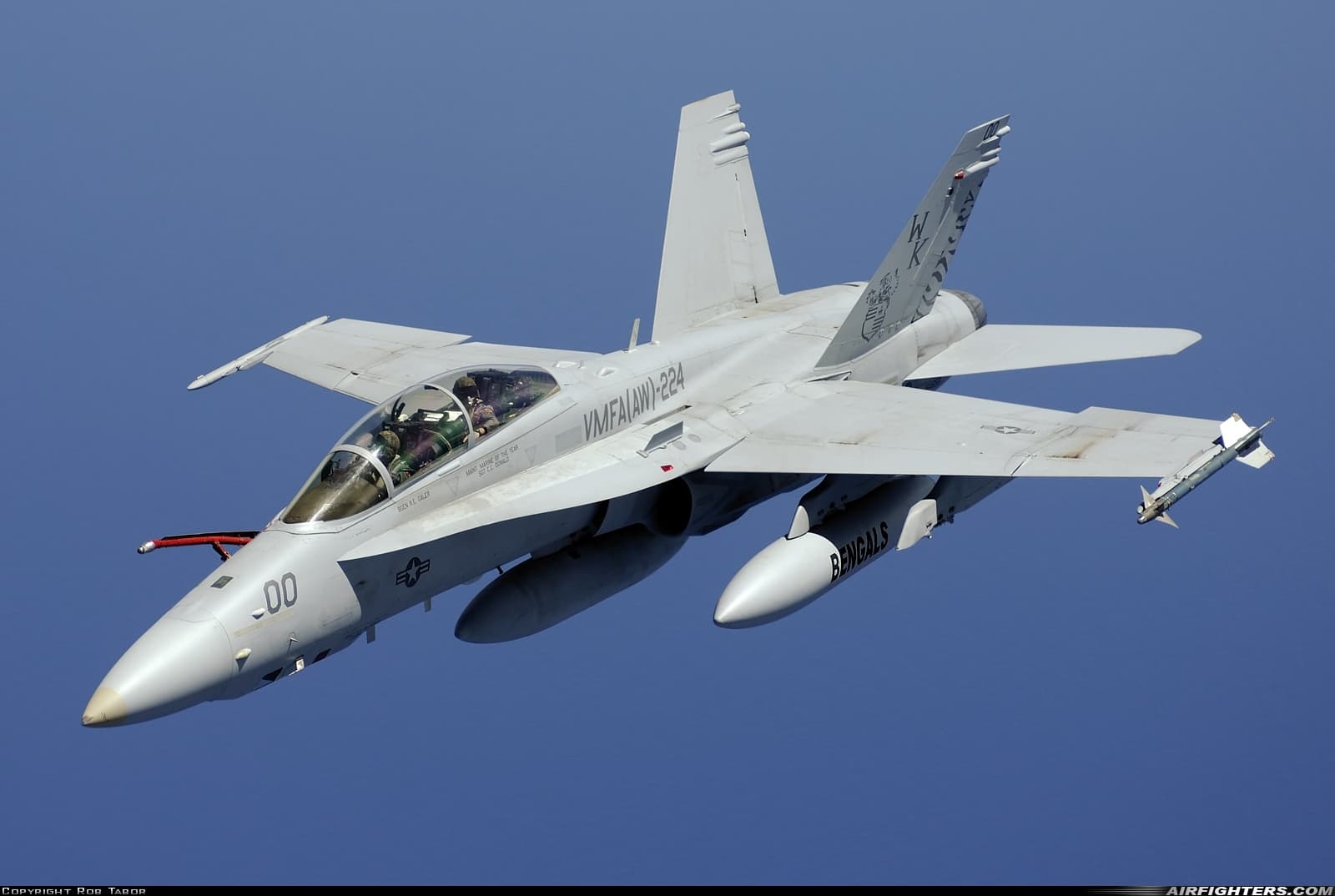The McDonnell Douglas F/A-18D is a twin-seat version of the F/A-18C often used for pilot training and multi-role operations. Entering service in 1987 and still serving today with the USMC the F/A-18D saw success during various conflicts and operations around the world.
History
In August 1971 the US Navy were looking for an alternative to the Grumman F-14 Tomcat that was cheaper and easier to service. Multiple proposals were made such as the F-14X by Grumman, a stripped down version of the F-14, and a naval variant of the F-15 by McDonnell Douglas. However the US Navy decided to look elsewhere for proposals as both would be almost as expensive as the current F-14’s that were in service. They looked at the proposals made to the US Airforce for their next fighter platform, those would be the YF-16 by General Dynamics, and the YF-17 by Northrop. The US Airforce chose the YF-16 and the Navy chose the YF-17.
As development began McDonnell Douglas would be brought on to be the primary contractor for the program with Northrop becoming the secondary partner. Both would work to improve upon the initial YF-17 design and in November of 1978 the Hornet would take it’s maiden flight. Originally starting as 3 variants, the single-seat F-18A, A-18A and twin-seat TF-18A, the F-18A and A-18A would be merged into one aircraft, now designated as the F/A-18A, and the TF-18A would be designated the F/A-18B. The now F/A-18A and F/A-18B Hornet’s would enter service in 1983 with the USMC and 1984 with the US Navy.
In 1987, a block upgrade would see the F/A-18A/B upgraded to the F/A-18C/D. This upgrade would bring a new radar, more advanced avionics, and the ability to employ advanced weapons such as AIM-120 AMRAAM variants, advanced AIM-9 Sidewinders, air to ground guided bombs and missiles such as the AGM-84 SLAM-ER, AGM-88 HARM Anti-radiation missile and AGM-84 Harpoon anti-ship missiles to name a few.
The F/A-18D differs slightly from the F/A-18C, it has the obvious second cockpit which makes it slightly heavier and it has a smaller capacity for internally stored fuel. But other than those it was effectively the same as the C model.
Specifications
Size
- Length - 17.1m
- Wing Span - 12.3m
- Height - 4.66m
- Wing Span - 32m²
Weight
- Empty Weight - 11,200kg
- Max Weight - 23,400kg
Engines
- 2 x F404-GE-402
Air to Air Missiles
- AIM-9L/M/X Sidewinder
- AIM-7M/P Sparrow
- AIM-120A/B/C/D AMRAAM
Gun
- M61A1 20mm Vulcan
Air-to-Ground Guided
- AGM-45 Shrike
- AGM-62 Walleye
- AGM-84 Harpoon
- AGM-84E SLAM
- AGM-84H/K SLAM-ER
- AGM-88 HARM
- AGM-123 Skipper II
- AGM-154 JSOW
- AGM-158 JASSM
- GBU-10/12/16 Paveway II
- GBU-24B Paveway III
- GBU-31/32/38 JDAM
- GBU-54/56 LJDAM
- APKWS II Guided Rockets
Air to Ground Unguided
- MK 82/83/84 bombs
- MK 82/83 high drag bombs
- MK 77 incendiary bombs
- Hydra 70 rockets
- Zuni rockets
Avionics
- AN/APG-73 Radar
- AN/APG-79(V)4 AESA Radar(Tested and in development with USMC since 2022)
- AN/ALR-67(V)3 RWR
- AN/AAQ-28(V)4 LITENING AT
- AN/ASQ-228 ATLFIR
- JHMCS HMD
- AN/ALE-47 Countermeasures (120 total)
- BOL Countermeasure Pods (Tested)
- Yes
- No
- Tech Tree Vehicle (Foldered with the F/A-18C)
- Tech Tree Vehicle (Standalone, before/after F/A-18C)
- Squadron Vehicle
- Event Vehicle
- Premium Vehicle
- I said no
- 13.3
- 13.7
- 14.0
- 14.3+
- I said no
Sources
America’s Navy - F/A-18A-D Hornet and F/A-18E/F Super Hornet Strike Fighter
Airfighters - McDonnell Douglas F/A-18D Hornet Aircraft Data
Bundeswehr - F/A-18C/D Hornet
Military.com - F/A-18C/D Hornet
Wikipedia - McDonnell Douglas F/A-18 Hornet
NAVAIR - F/A-18 A-D Hornet
Wikiwand - McDonnell Douglas F/A-18 Hornet
